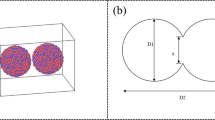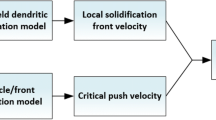Abstract
This study employed molecular dynamics simulation to investigate the behavior of Fe35Ni atoms during the melting and sintering processes. The nanoparticle’s melting temperature was initially determined, and its melting behavior was subsequently examined. The sintering of two individual particles and a multiparticle system was analyzed to observe morphological changes. The basic understanding of sintering behavior at atomic scale was explored by examining the relationship between sintering temperature and process parameters like radius ratio, dihedral angle, radial distribution function, and mean square displacement. A complete sintering cycle, heating-holding-cooling, was simulated in this work. A detailed analysis focused on an 8-nm particle size to gain insights into sintering behavior and sintering mechanism. The mechanisms involved during sintering were found to be surface diffusion and grain boundary diffusion. Diffusivity of atoms at higher sintering temperature is around 10 times higher than diffusivity at lower sintering temperature indicates faster sintering at higher temperature. The study also delves into the sintering behavior of multiparticle nanoparticles system. The bulk diffusion, volume diffusion, and dislocation assist densification mechanism, i.e., sintering due to plastic flow was observed during multiparticle system. Furthermore, it is anticipated that the molecular dynamics simulation model developed in this work will serve as the foundation for multiscale modelling of sintering phenomena.
Graphical Abstract
















Similar content being viewed by others
Data availability
Data will be made available on request.
References
Gheisari K, Oh JT, Javadpour S (2011) The effect of heat treatment on the structure and magnetic properties of mechanically alloyed Fe–45%Ni nanostructured powders. J Alloys Compd 509:1020–1024. https://doi.org/10.1016/J.JALLCOM.2010.09.159
Sato H, Nishiura T, Moritani T, Watanabe Y (2023) Atypical phase transformation behavior of Fe-33%Ni alloys induced by shot peening. Surf Coat Technol 462:129470. https://doi.org/10.1016/J.SURFCOAT.2023.129470
Li Y, Cai X, Zhang G et al (2022) Optimization of electrodeposition nanocrytalline Ni-Fe alloy coatings for the replacement of Ni coatings. J Alloys Compd 903:163761. https://doi.org/10.1016/J.JALLCOM.2022.163761
Hong LB, Fultz B (1998) Two-phase coexistence in Fe–Ni alloys synthesized by ball milling. J Appl Phys 79:3946–3955. https://doi.org/10.1063/1.361821
Qin F, Lu F, Chen Y et al (2018) Deformation induced elinvar behavior in Fe-Ni invar alloy. Sci Bull 63:1040–1042. https://doi.org/10.1016/j.scib.2018.07.006
Moruzzi VL (1992) Theory of invar. Solid State Commun 83:739–743. https://doi.org/10.1016/0038-1098(92)90155-3
Cao D (2023) Fusion joining of thermoplastic composites with a carbon fabric heating element modified by multiwalled carbon nanotube sheets. Int J Adv Manuf Technol 128:4443–4453. https://doi.org/10.1007/S00170-023-12202-6/TABLES/4
Cao D (2023) Enhanced buckling strength of the thin-walled continuous carbon fiber–reinforced thermoplastic composite through dual coaxial nozzles material extrusion process. Int J Adv Manuf Technol 128:1305–1315. https://doi.org/10.1007/S00170-023-12014-8/TABLES/6
Cao D, Bouzolin D, Lu H, Griffith DT (2023) Bending and shear improvements in 3D-printed core sandwich composites through modification of resin uptake in the skin/core interphase region. Compos B Eng 264:110912. https://doi.org/10.1016/J.COMPOSITESB.2023.110912
Si PZ, Choi CJ (2018) High hardness nanocrystalline invar alloys prepared from Fe-Ni nanoparticles. Metals 8:28. https://doi.org/10.3390/met8010028
Jiang J, Chen P, Sun W (2020) Monitoring micro-structural evolution during aluminum sintering and understanding the sintering mechanism of aluminum nanoparticles: a molecular dynamics study. J Mater Sci Technol 57:92–100. https://doi.org/10.1016/J.JMST.2020.03.068
Wu R, Zhao X, Liu Y (2021) Atomic insights of Cu nanoparticles melting and sintering behavior in CuCu direct bonding. Mater Des 197:109240. https://doi.org/10.1016/J.MATDES.2020.109240
Alavi S, Thompson DL (2006) Molecular dynamics simulations of the melting of aluminum nanoparticles. J Phys Chem A 110:1518–1523. https://doi.org/10.1021/JP053318S
Li Y, Goyal A, Chernatynskiy A et al (2016) Nanoindentation of gold and gold alloys by molecular dynamics simulation. Mater Sci Eng A 651:346–357. https://doi.org/10.1016/J.MSEA.2015.10.081
Gao Y, Ruestes CJ, Urbassek HM (2014) Nanoindentation and nanoscratching of iron: atomistic simulation of dislocation generation and reactions. Comput Mater Sci 90:232–240. https://doi.org/10.1016/J.COMMATSCI.2014.04.027
Wang W, Hua D, Luo D et al (2022) Molecular dynamics simulation of deformation mechanism of CoCrNi medium entropy alloy during nanoscratching. Comput Mater Sci 203:111085. https://doi.org/10.1016/J.COMMATSCI.2021.111085
Song P, Wen D (2010) Molecular dynamics simulation of the sintering of metallic nanoparticles. J Nanopart Res 12:823–829. https://doi.org/10.1007/S11051-009-9718-7/FIGURES/6
Liu ZJ, Cheng Q, Wang Y et al (2020) Sintering neck growth mechanism of Fe nanoparticles: a molecular dynamics simulation. Chem Eng Sci 218:115583. https://doi.org/10.1016/J.CES.2020.115583
Hu Y, Wang Y, Yao Y (2023) Molecular dynamics on the sintering mechanism and mechanical feature of the silver nanoparticles at different temperatures. Mater Today Commun 34:105292. https://doi.org/10.1016/J.MTCOMM.2022.105292
Luo S, Luo J, Kang Q et al (2022) Molecular dynamics simulation and experimental verification of the crystallization behavior of a Ti–Zr–Ni alloy prepared by SPS low temperature liquid phase sintering. Vacuum 206:111491. https://doi.org/10.1016/J.VACUUM.2022.111491
Li X, Shi Y, Chen T et al (2022) Study on sintering mechanism and mechanical properties of Fe–Ni elastocaloric refrigeration alloy through molecular dynamics simulation. Mater Today Commun 32:103913. https://doi.org/10.1016/J.MTCOMM.2022.103913
Zhang J, Zhang Y, Lee WH, et al (2021) A multi-scale multi-physics modeling framework of laser powder bed fusion additive manufacturing process. 73:151–157. https://doi.org/10.1016/J.MPRP.2018.01.003
Nandy J, Yedla N, Gupta P et al (2019) Sintering of AlSi10Mg particles in direct metal laser sintering process: a molecular dynamics simulation study. Mater Chem Phys 236:121803. https://doi.org/10.1016/j.matchemphys.2019.121803
Abedini A, Montazeri A, Malti A, Kardani A (2022) Mechanical properties are affected by coalescence mechanisms during sintering of metal powders: case study of Al-Cu nanoparticles by molecular dynamics simulation. Powder Technol 405:117567. https://doi.org/10.1016/J.POWTEC.2022.117567
Singh R, Sharma V (2021) Nano tungsten carbide interactions and mechanical behaviour during sintering: a molecular dynamics study. Comput Mater Sci 197:110653. https://doi.org/10.1016/J.COMMATSCI.2021.110653
Ueno K, Shibuta Y (2020) Molecular dynamics study of composition dependence of solid-liquid interfacial energy of Fe-Ni binary alloy. IOP Conf Ser Mater Sci Eng 861:012064. https://doi.org/10.1088/1757-899X/861/1/012064
Thompson AP, Aktulga HM, Berger R et al (2022) LAMMPS - a flexible simulation tool for particle-based materials modeling at the atomic, meso, and continuum scales. Comput Phys Commun 271:108171. https://doi.org/10.1016/J.CPC.2021.108171
Stukowski A (2010) Visualization and analysis of atomistic simulation data with OVITO–the open visualization tool. Model Simul Mat Sci Eng 18:015012. https://doi.org/10.1088/0965-0393/18/1/015012
Bonny G, Pasianot RC, Malerba L (2009) Fe-Ni many-body potential for metallurgical applications. Model Simul Mat Sci Eng 17:025010. https://doi.org/10.1088/0965-0393/17/2/025010
Feng J, Dai K, Zhou Q et al (2019) Formation of bonding interface in explosive welding—a molecular dynamics approach. J Phys Condens Matter 31:415403. https://doi.org/10.1088/1361-648X/AB30D7
Sun W, Chen P (2020) Dynamic contact behaviours involving crystalline diamond nanospheres. Eur J Mech A Solids 80:103896. https://doi.org/10.1016/J.EUROMECHSOL.2019.103896
Chakraborty P, Zachariah MR (2014) Do nanoenergetic particles remain nano-sized during combustion? Combust Flame 161:1408–1416. https://doi.org/10.1016/J.COMBUSTFLAME.2013.10.017
Yang Z, Yang X, Xu Z (2008) Molecular dynamics simulation of the melting behavior of Pt-Au nanoparticles with core-shell structure. J Phys Chem C 112:4937–4947. https://doi.org/10.1021/JP711702Y/SUPPL_FILE/JP711702Y-FILE014.PDF
Sankaranarayanan SKRS, Bhethanabotla VR, Joseph B (2005) Molecular dynamics simulation study of the melting of Pd-Pt nanoclusters. Phy Rev B 71:195415. https://doi.org/10.1103/PhysRevB.71.195415
Kingery WD, Berg M (1955) Study of the initial stages of sintering solids by viscous flow, evaporation-condensation, and self-diffusion. J Appl Phys 26:1205–1212. https://doi.org/10.1063/1.1721874
Sun W, Zeng Q, Yu A, Kendall K (2013) Calculation of normal contact forces between silica nanospheres. Langmuir 29:7825–7837. https://doi.org/10.1021/LA401087J/ASSET/IMAGES/LARGE/LA-2013-01087J_0018.JPEG
Asoro MA, Kovar D, Shao-Horn Y et al (2009) Coalescence and sintering of Pt nanoparticles: in situ observation by aberration-corrected HAADF STEM. Nanotechnology 21:025701. https://doi.org/10.1088/0957-4484/21/2/025701
Kolosov AY, Sokolov DN, Sdobnyakov NY et al (2017) Estimation of the dihedral angle between metal nanoparticles during their coalescence. J Nano- and Electron Phys 9:05042–05044. https://doi.org/10.21272/JNEP.9(5).05042
Delannay F (2015) Influence of dihedral angle and grain coordination on densification rate during intermediate and final sintering stages. J Am Ceram Soc 98:3469–3475. https://doi.org/10.1111/JACE.13577
Kart HH, Yildirim H, Kart SO, Çagin T (2014) Physical properties of Cu nanoparticles: a molecular dynamics study. Mater Chem Phys 147:204–212. https://doi.org/10.1016/j.matchemphys.2014.04.030
Fang ZZ, Wang H (2010) Sintering of ultrafine and nanosized particles. In: Sintering of Advanced Materials. Elsevier 434–473
Seong Y, Kim Y, German R et al (2016) Dominant mechanisms of the sintering of copper nano-powders depending on the crystal misalignment. Comput Mater Sci 123:164–175. https://doi.org/10.1016/J.COMMATSCI.2016.06.016
German RM (2014) Thermodynamic and Kinetic Treatments. Sintering: from Empirical Observations to Scientific Principles 183–226. https://doi.org/10.1016/B978-0-12-401682-8.00007-0
Silman GI (2012) Compilative FE - NI phase diagram with author’s correction. Met Sci Heat Treat 54:105–112. https://doi.org/10.1007/s11041-012-9463-x
Singh N, Parkash O, Kumar D (2018) Phase evolution, mechanical and corrosion behavior of Fe(100–x) Ni(x) alloys synthesized by powder metallurgy. J Phys Chem Solids 114:8–20. https://doi.org/10.1016/j.jpcs.2017.10.045
Chan TY, Lin ST (1997) Sintering of elemental carbonyl iron and carbonyl nickel powder mixtures. J Mater Sci 32:1963–1967. https://doi.org/10.1023/A:1018537814204
Herring C (1950) Effect of change of scale on sintering phenomena. J Appl Phys 21:301–303. https://doi.org/10.1063/1.1699658
Thümmler F, Thomma W (1967) The sintering process. Metall Rev 12:69–108. https://doi.org/10.1179/MTLR.1967.12.1.69
Cheng B, Ngan AHW (2013) The sintering and densification behaviour of many copper nanoparticles: a molecular dynamics study. Comput Mater Sci 74:1–11. https://doi.org/10.1016/j.commatsci.2013.03.014
Acknowledgement
We acknowledge National Supercomputing Mission (NSM) for providing computing resources of Param Sanganak at IIT Kanpur, which is implemented by C-DAC and supported by the Ministry of Electronics and Information Technology (MeitY) and Department of Science and Technology (DST), Government of India. We also acknowledge the HPC facility provided by CC, IIT Kanpur.
Author information
Authors and Affiliations
Contributions
SKS provided conceptualization, methodology, software, investigation, formal analysis, validation, and writing—original draft. SB conducted resources, supervision, and writing—review & editing. AU performed resources, supervision, and writing—review & editing.
Corresponding author
Ethics declarations
Conflict of interest
The authors declare that they have no known competing financial interests or personal relationships that could have appeared to influence the work reported in this paper.
Additional information
Handling Editor: Ghanshyam Pilania.
Publisher's Note
Springer Nature remains neutral with regard to jurisdictional claims in published maps and institutional affiliations.
Supplementary Information
Below is the link to the electronic supplementary material.
Rights and permissions
Springer Nature or its licensor (e.g. a society or other partner) holds exclusive rights to this article under a publishing agreement with the author(s) or other rightsholder(s); author self-archiving of the accepted manuscript version of this article is solely governed by the terms of such publishing agreement and applicable law.
About this article
Cite this article
Sahni, S.K., Bhowmick, S. & Upadhyaya, A. Molecular dynamics simulations of solid-state sintering in Fe35Ni alloy: understanding the process at the atomic scale. J Mater Sci 59, 2954–2973 (2024). https://doi.org/10.1007/s10853-024-09404-y
Received:
Accepted:
Published:
Issue Date:
DOI: https://doi.org/10.1007/s10853-024-09404-y




